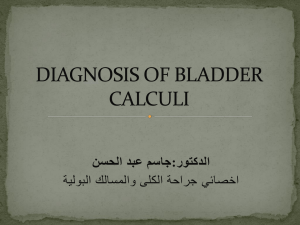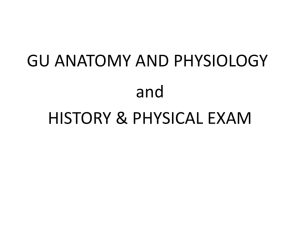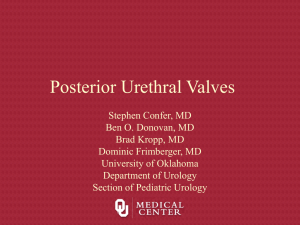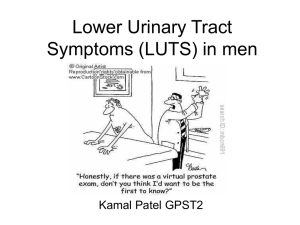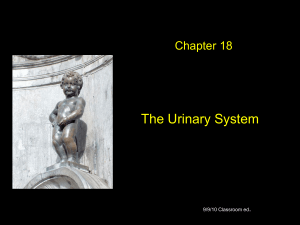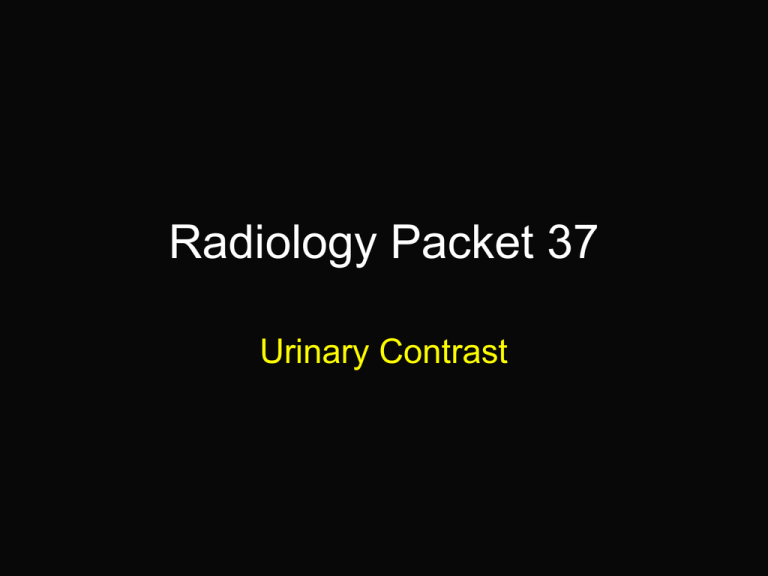
Radiology Packet 37
Urinary Contrast
1 yr old MC Miniature Poodle
“Poutchi”
• HX = presented because he was hit by a car, one
survery film was done followed by a
urethrogram/cystogram
1 yr old MC Miniature Poodle
“Poutchi”
1 yr old MC Miniature Poodle
“Poutchi”
•
RF
– There is reduced abdominal detail on the survey radiograph, questionable
retroperitoneal detail and the urinary bladder cannot be visualized.
– There are multiple pelvic fractures including the shaft of one ilium and the pelvic
floor.
– On the urethrogram the urinary catheter has been advanced into the mid-portion
of the penile urethra.
– The urinary bladder has filled to some degree, there is a massive amount of
contrast material within the peritoneal and retroperitoneal space.
– Note the kidneys are filtering the contrast and the renal pelvis’ and ureters are
seen.
– The filling of the urinary bladder indicates that at least one ureter is reaching the
bladder.
•
RD
– Avulsion of the prostatic urethra from the urinary bladder secondary to severe
pelvic trauma, including fractures.
2 yr old MC Labrador Retriever
“Homer”
• HX = presented for bloody urine
2 yr old MC Labrador Retriever
“Homer”
2 yr old MC Labrador Retriever
“Homer”
2 yr old MC Labrador Retriever
“Homer”
2 yr old MC Labrador Retriever
“Homer”
•
RF
–
–
–
–
–
–
•
On the survey radiographs there is markedly reduced retroperitoneal space detail.
The kidneys are not visualized at all and the colon is displaced ventrally.
The urinary bladder is not well seen.
On the excretory urogram films both kidneys and ureters are intact.
The right renal pelvis and diverticula are dilated, the left is normal.
A large filling defect within the urinary bladder, occupying the trigonal region, is positioned to
the right.
RD
–
–
–
Retroperitoneal fluid or mass
Intact urinary system
Large space occupying mass eccentrically located to the right within the trigone causing right
hydronephrosis
8 yr old M GSD
“Ben”
• HX = presented
with a history of
dysuria and
passing fresh
blood at the end
of urination,
physical
examination
revealed
prostatic
enlargement
8 yr old M GSD
“Ben”
•
RF
– This is a normal retrograde urethrogram, the prostate is visible and is within
normal limits(<70% of sacro-pubic distance).
– The prostatic urtehra is relatively wide, slight narrowing of the urethra is seen
proximal and distal to the ischial arch and the urethra is wide as it curves around
the arch.
– The unusual appearance of the contrast as it enters the bladder is the result of
contrast entering under pressure.
4 yr old M Dalmatian
“Max”
• HX = history
of stranguria
and
pollakiuria,
after
physical
exam a
urinary
catheter was
unable to be
passed
4 yr old M Dalmatian
“Max”
4 yr old M Dalmatian
“Max”
•
RF
–
–
–
–
–
–
•
RD
–
–
•
In the film with the legs in neutral position multiple filling defects within the central contrast
pool in the bladder.
Three filling defects are present in the urethra at the proximal end of the os penis.
Filling of the urethra with contrast is good in the prostatic region but poor in the perineal
region.
A round filling defect visible at the end of the urethral catheter is thought to be an air-bubble.
In the films with the legs pulled cranially the three filling defects at the proximal end o f the os
penis are more clearly seen.
Due to an increasing volume of contrast material there is better distension of the perineal
urethra, it is normal in appearance.
Cystic calculi
Urethral calculi
Next
–
Surgery
3 yr old M DSH
“Marmalade”
• No HX given
3 yr old M DSH
“Marmalade”
•
RF
– A retrograde urethrogram was performed and positive contrast material fills the
urethra and enters the bladder which is moderately distended.
– Several distinct filling defects are present in the prostatic urethra just caudal to
the bladder neck.
– The contrast material in the remainder of the prostatic urethra is indistinct
(stippled) in appearance.
– A round gas bubble is visible within the center of the bladder.
– The linear structure of gas lucency in the cranial bladder is a superimposed gasfilled bowel segment.
•
RD
– Urethral calculi
– Feline Lower Urinary Tract Disease (FLUTD)
7 yr old M DLH
“Blackie”
• HX = history of hematuria
7 yr old M DLH
“Blackie”
7 yr old M DLH
“Blackie”
7 yr old M DLH
“Blackie”
7 yr old M DLH
“Blackie”
•
RF
–
–
–
–
–
–
•
On the double contrast cystogram there is no contrast adherence to the mucosa of the apical
portion of the bladder.
The renal diverticula have filled with contrast, they are normal and seen as fine, detailed
linear tubular structures.
The immediate films(2 films on 1 slide) nicely show the nephrogram phase of the excretory
urogram, the kidneys show a homogenous blush.
The urinary bladder and urethra have been filled with air prior to the IVP.
The pyelogram portion of the IVP demonstrates pelves and ureters.
The urinary bladder wall is noted to be mildly thickened, as the wall is followed from the
trigone to the apex it becomes thicker, approx. 5 mm thick.
RD
–
Mild cystitis
6 mo old F Mix Breed Dog
“OC”
• HX = dribbling
urine since
puppyhood, but
she also
urinates
normally
6 mo old F Mix Breed Dog
“OC”
6 mo old F Mix Breed Dog
“OC”
6 mo old F Mix Breed Dog
“OC”
•
•
RF
– Markedly dilated left ureter, the left renal pelvis is also dilated.
– The left ureter can be seen to enter the trigonal region in a normal location, then
“tunnels” along the left side of the trigone, into the proximal urethra.
– Note that the urethra fills with contrast , an abnormal finding.
– The urinary bladder fills with contrast.
– A mild lateral cortical depression is noted in the left kidney.
– The right ureter and kidney are normal.
RD
– Ectopic left ureter
– Left hydroureter/nephrosis which is secondary to chronic irritation, ascending
infection
M DSH
“Scooter”
• HX = the top film
was obtained prior
to a perineal
urethrostomy, the
bottom film was
obtained because
the patient
presented with
signs of urinary tract
obstruction
M DSH
“Scooter”
•
RF
–
–
–
–
–
–
–
•
In the initial film the kidneys are visible and appear approximately normal size.
The urinary bladder contains a single 2 mm round mineral opacity structure.
There is a granular appearance to the ventral aspect of the bladder suggesting that
mineralized sediment is present.
Irregular mineral opacity material is present in the pelvic and proximal penile urethra.
In the second film there are multiple variably-sized mineral opacity structures within the
bladder and extending into the bladder neck.
The bladder neck appears elongated.
A gas bubble is also present within the bladder lumen.
RD
–
–
On the initial film, cystic calculus with evidence of mineralized bladder sediment and
mineralized sediment/small calculi within the urethra
On the second film, multiple cystic calculi
6 yr old MC DSH
“Gus”
• HX = long history of frequent urination and intermittent
hematuria
6 yr old MC DSH
“Gus”
6 yr old MC DSH
“Gus”
•
•
•
RF
– The bladder wall is markedly thickened and there is irregular mucoas present.
– The first positive contrast cystogram shows large filling defects within the lumen.
– The second film was taken following maximum distension of the urinary bladder,
note how thick the bladder wall is.
– Excellent filling of the urethra was achieved, in fact the urethra is quite large for a
male cat and may be dilated due to chronic irritation.
RD
– Severe cystitis
Next
– Surgical curettage of the bladder mucosa
16 yr old FS German Shepherd
“Princess”
• HX = presented for evaluation of recurrent urinary tract
infection and hematuria
16 yr old FS German Shepherd
“Princess”
16 yr old FS German Shepherd
“Princess”
•
RF
–
–
–
–
–
–
–
•
On the negative contrast cystogram the apical portion of the bladder wall is thickened,
particularly the ventral bladder wall.
The mucosal surface in the area of wall thickening is irregular.
The gas outlines a triangular extension of the bladder lumen in the apical region.
The faintly seen linear structure in the bladder lumen is a catheter.
On the double contrast cystogram a small amount of contrast is seen adherent to the bladder
mucosa in the apical region.
The triangular exentsion of the bladder lumen in the apical region is unchanged in
appearance.
The catheter is now easily seen since it contains radiopaque contrast.
RD
–
Chronic cystitis
6.5 yr old DSH
• HX = history of
weight loss and a
somewhat tender
abdomen
6.5 yr old DSH
6.5 yr old DSH
6.5 yr old DSH
6.5 yr old DSH
•
RF
–
–
–
–
–
–
–
–
–
•
On the survey radiographs the left kidney is of normal size, the right kidney is small.
A round focus of mineral opacity is seen in the left cranio-dorsal abdomen approximately at
the level of L3.
Careful evaluation of this structure reveals that it is not in the GI tract.
In the lateral view a tiny linear soft tissue structure is seen cranial to the object.
A similar mineral opacity object is present in the bladder.
On the IVU radiographs both kidneys opacify indicating both are functional.
There is dilation of the collecting system and proximal ureter on the left.
The ureteral distension ends at the mineral opacity that was previously described.
The mineral opacity structure in the bladder is barely visible.
RD
–
–
–
Ureteral calculi
Cystic calculi
Hydronephrosis and hydroureter of the left kidney secondary to ureteral obstruction



